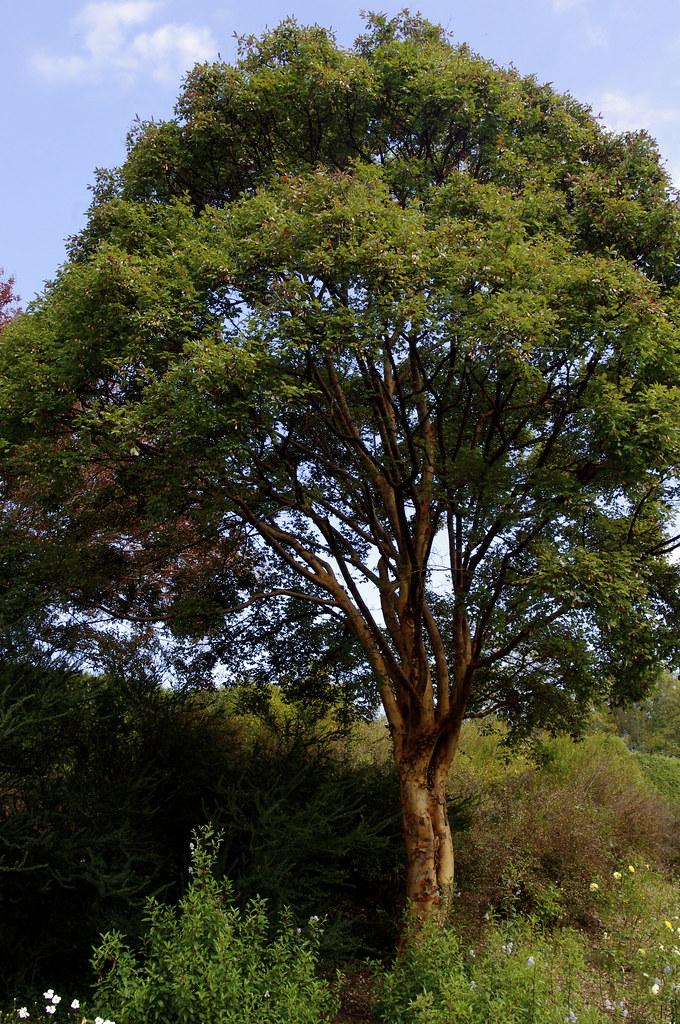

Paperbark Maple (Acer griseum)
Also known as: Acer griseum.
The Paperbark Maple (Acer griseum) captivates with its distinctive cinnamon-hued bark that exfoliates in fine layers, coupled with its graceful leaves. Come springtime, the tree is adorned with subtle pink and white blossoms, contributing to its charm. As autumn arrives, the leaves transition to a stunning copper-bronze, ensuring year-round visual interest as an ornamental specimen. Requiring minimal upkeep and straightforward to cultivate, the Paperbark Maple is perfectly suited for a protected area within your garden. It also serves as an excellent natural screen for added privacy around patios or swimming pools. With its beauty and adaptability, the Paperbark Maple is an essential element for any landscape.
Interesting facts about the Paperbark Maple:
- Ancient Origins: The Paperbark Maple is native to central China and has been around for centuries. It was first introduced to Western cultivation in 1901 by plant explorer Ernest Wilson, who found it growing in the mountains of western Hubei and eastern Sichuan provinces.
- Unique Bark: The tree gets its name from its distinctive coppery-brown, peeling bark. The bark is its most prominent feature, which peels away in thin, papery layers, giving it the name ‘Paperbark’. This unique bark makes it an attractive feature in a winter landscape.
- Fall Color Display: The Paperbark Maple is known for its stunning fall color. Its leaves turn from green to a vibrant mix of reds and oranges in autumn, making it a showstopper during the fall season.
- High Value Timber: The wood from the Paperbark Maple is dense and resistant to splitting, which makes it highly valued for furniture making and other woodworking projects.
- Medicinal Uses: In traditional Chinese medicine, the bark and leaves of the Paperbark Maple have been used to treat coughs, colds, and fever. It’s also been used as a tonic to improve overall health and vitality.
- Slow Grower: The Paperbark Maple is a slow-growing tree, often only growing a foot a year. This makes it an ideal tree for small gardens or landscapes where space is limited.
- Endangered Status: Despite its beauty and usefulness, the Paperbark Maple is listed as “endangered” in its native China due to habitat loss. Efforts are underway to preserve and propagate this beautiful tree for future generations to enjoy.
Plant care guide:
Sunlight
Paperbark Maple does well in full sun, but can also tolerate partial shade, so you want to make sure it gets at least 6 hours of sunlight per day. The best times for it to receive sunlight are in the morning and early afternoon, as the intense afternoon sun can cause the leaves to scorch. Morning sunlight will encourage blooms later in the year and will help the tree build up its food reserves.
Watering
Paperbark Maple thrives in moist but well-drained soil and should be watered regularly during the growing season with approximately 5 cm of water per week. It should be watered deeply but infrequently, giving the soil time to dry out between waterings. Water should be applied around the perimeter of the plant to ensure it is penetrating deeply into the root zone. During the winter, when the plant is dormant, watering should be reduced significantly. Paperbark Maple does not tolerate overly wet soil and will not survive standing water, so make sure to check the soil before watering and not to overwater.
Pruning
Paperbark Maple (Acer griseum) should be pruned twice each year, once in early spring and once in late summer. In early spring, prune only to remove dead and diseased branches. Late summer pruning should be more extensive, and can include removing excess watersprouts and crossed branches, thinning out interior growth, and shaping the tree’s overall canopy. Care should be taken to not prune more than 1/3 of the tree’s growth in a single session, and to prune any branches back to their points of origin or to another branch or branchlet at least 1 thumb’s width in diameter.
Plant information:
- Family: Sapindaceae
- Type: Tree
- Height: ~9.14 meters
- Cycle: Perennial
- Growth Rate: Low
-
Anatomy:
- Trunk: brown
- Branches: brown
- Leaves: dark-green, light-green
- Flower Color: Green
- Maintenance: Low
- Care Level: Medium
-
Watering:
- ~5 cm
- Average
- Every 3-4 days
- Sunlight requirement: Full sun, part shade
- Pruning:
- March, April, August, March, April, August
- 2 times yearly
- Propagation: Seed Propagation, Greenwood Cuttings, Hardwood Cuttings
- Pest Susceptibility: Galls, Heart rot, Mites, Root rot, Pest resistant, Disease resistant
- Flowering Season: Spring
- Soil: Acidic, Well-drained
- Harvest Season: Fall
- Origin: Central and eastern China
- Seeds: No
- Drought Tolerant: No
- Salt Tolerant: No
- Thorny: No
- Invasive: No
- Tropical: No
- Indoor: No
- Flowers: Yes
- Cones: No
- Fruits: Yes
- Edible Fruit: No
- Leaf: Yes
- Edible Leaf: No
- Cuisine: No
- Medicinal: No
- Poisonous to Humans: No
- Poisonous to Pets: No

Sources & more information:
Content is based on public databases such as the KEW Plants of the World database, among others. Please double-check all information. "About Plants" does not take responsibility for any inaccuracies.
